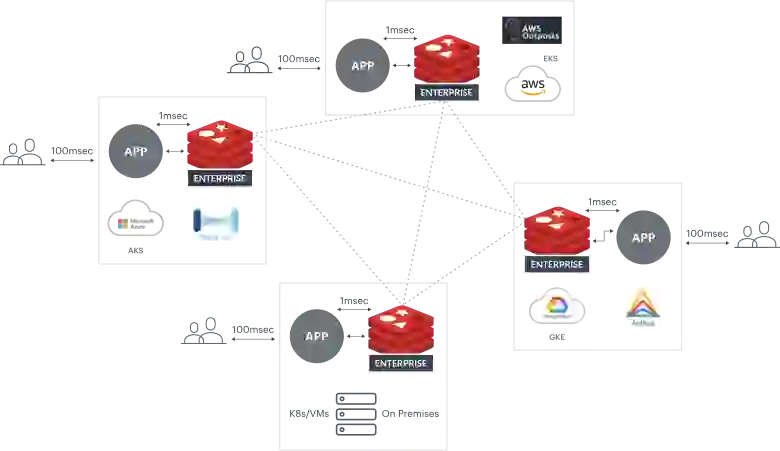Video

Learn more
Multicloud is the new norm—don’t get left behind by slow, siloed data. Run the same application across multiple clouds with Redis Cloud.

Organizations are increasingly implementing hybrid and multicloud deployment strategies. Today, there’s an average of 2 public and 2 private clouds leveraged across the enterprise stack and 1 in 3 applications are built across multiple public clouds.
Multicloud allows businesses to operate with freedom, avoid data and vendor lock-in, increase resilience, and tailor each cloud’s best-in-breed services to workflows in their application portfolio.


Each cloud or hybrid environment requires its own disparate data layer. This fragmentation leads to performance degradation, frequent data conflict issues, and a multitude of databases to manage across cloud providers and data use cases.
Redis Cloud enables seamless multicloud deployments from a single console, provides a unified data layer across clouds with consistency, and delivers Redis’ sub-millisecond performance to power applications for the new data economy.

Running an enterprise or application across multiple clouds results in a myriad of database services per cloud provider. Each requires management for tasks like deployment, monitoring, scaling, resharding, updates, and general maintenance—resulting in an operational nightmare.
Redis Cloud enables customers to deploy real-time databases across multiple clouds using a single platform. Once deployed, databases are fully managed with enterprise support, ensuring databases are available as well as optimized—wherever they are deployed. Also, Redis Cloud is completely serverless so the infrastructure concerns are fully abstracted away.
Distributed multicloud applications generate a massive quantity of read and write requests to databases spanning multiple clouds and geographies. The enormous and simultaneous volume of data activity across users, geographies, and clouds leads to significant issues with data conflict—impacting user experiences and degrading data quality.
CRDT-based Active-Active Geo-Distribution runs behind the scenes across regions, clouds, and on-premises, delivering unmatched performance and preventing data consistency issues. Active-Active Geo-Distribution allows applications to read and write simultaneously to or from any replica, anywhere, while maintaining consistency across the entire data layer.
Multicloud is complex enough, but gets even more complicated as businesses deploy a multitude of database services within each cloud to meet individual data use cases, especially with microservices architectures. Not only does this compound operational challenges, but also exponentially increases cloud total cost of ownership.
Redis Cloud not only eliminates the need for a data layer per cloud, but also for databases or services to meet specific use cases. Redis Modules empower developers to easily model any modern real-time data use case while providing an instant data experience to users, and is perfectly suited for a microservices architecture.
Redis Cloud delivers infinite linear scaling, splits loads across multiple cores on every compute node, automatically reshards and rebalances as you scale, and delivers sub-millisecond performance on all data types and models.
Enable a seamless migration to the cloud with Redis Cloud’s Active-Passive technology or between clouds using Active-Active Geo-Replication.
Maximize innovation utilizing each cloud’s best-in-breed capabilities for your individual applications or workflows, without fragmenting your data layer.
While cloud services are highly resilient, outages do happen. A multicloud approach keeps your data available even during region or entire cloud outages, Redis Cloud delivers ultra-high availability with 99.999% uptime and robust backup, cluster-recovery, and disaster-recovery mechanisms.
A single EDP deal with Redis Cloud covers consumption commitments for multiple cloud providers, while providing a cost-effective solution for hosting large datasets by combining DRAM, SSD (Flash), and persistent memory.